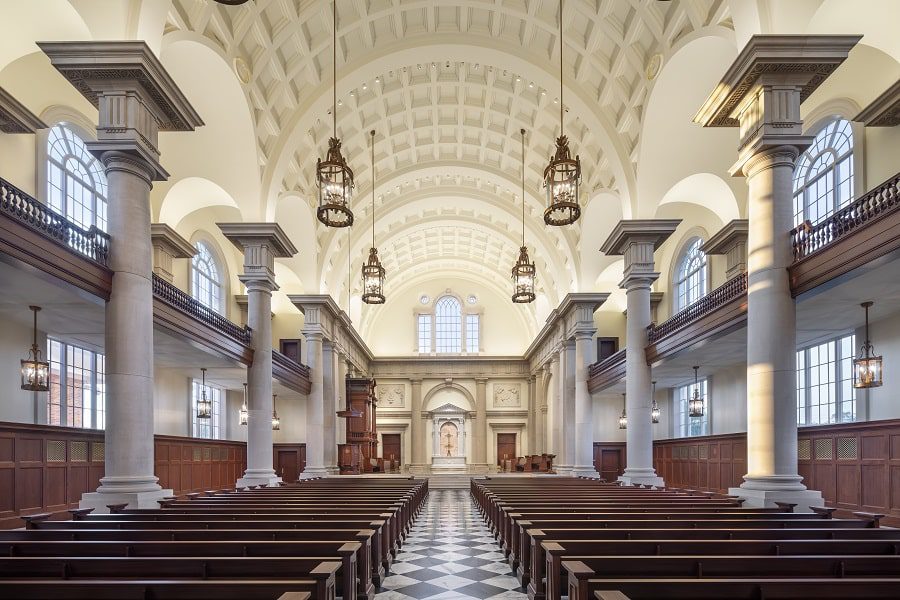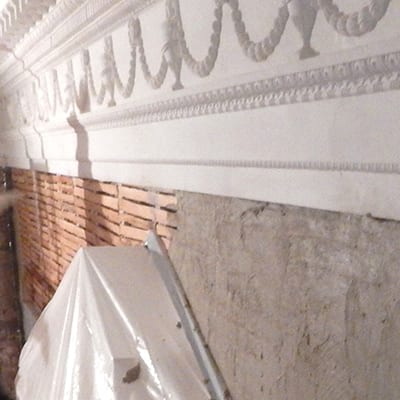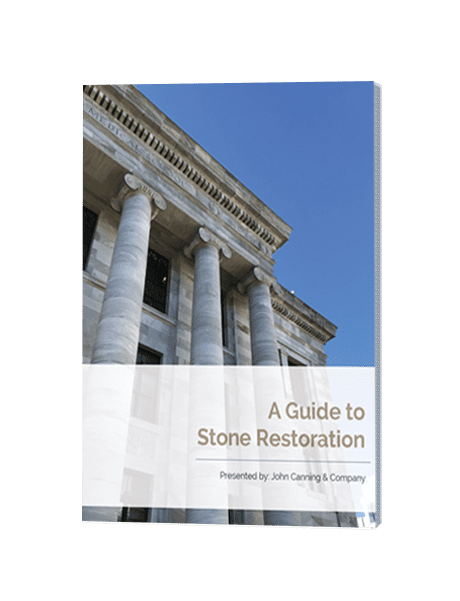First used in the Renaissance as a way of imitating marble, the complex process of Scagliola plaster has remained on of the most widely used means to simulate expensive stone materials. The powerful Medici family were the first to use the method in the late 17th Century as a way of achieving the look of marble columns, without having to quarry and transport fine stone—an exceedingly difficult and costly process without modern technology to assist. Soon the technique spread throughout Tuscany, and was incorporated in object d’arts. Since stone no longer had to be cut to create marble inlays, extremely fine patterns (previously impossible to craft) could now be incorporated into floor and wall designs. Scagliola revolutionized marbleizing and the technique soon was popularized across Europe.
While easily mistaken for stone, the finishing technique is nothing more than plaster applied to a wood, stone, or brick substrate—with the principle ingredient being a form of gypsum known as Scagliola, which is mined in northern Italy. Warmer to the touch and sounding hollow when tapped, there are a few signs that instantly give away this marbling techniques secret but the addition of marble flakes, dust, and pieces makes it near impossible to tell the difference from afar.
ARVE Error: src mismatchprovider: youtube
url: https://www.youtube.com/watch?v=VxiBT_Q4mo8&t=1s
src in org: https://www.youtube-nocookie.com/embed/VxiBT_Q4mo8?start=1&feature=oembed
src in mod: https://www.youtube-nocookie.com/embed/VxiBT_Q4mo8?start=1
src gen org: https://www.youtube-nocookie.com/embed/VxiBT_Q4mo8
Traditional “Italian” scagliola plaster starts out as a gypsum, animal glue, water, and pigment mix. These ingredients are mixed well and inserted into a plaster mold. In order to accurately depict marble, which can have upwards of 20 colors and clarity levels, many different pigmented mixes and clarity levels must be made. These layers are poured into the mold in a manner that would mimic natural layering found in the marble being copied. In order to achieve the desired veining finish, there are a few techniques skilled artisans use. The first approach requires the use of silk strings. Pigmented, the silk strings are pulled through the plaster medium in the mold, leaving behind “veins” of color. This method can be too challenging if a tall column is being made in a mold, but might be used to create smaller pieces. The second method, and most common, involves various layers of pigmented plaster being troweled on and then cut back randomly to sublayers, revealing different colors. This produces the desired vein effect that successfully simulates marble. Each troweled-on layer is made separately with different pigments, stone dust/pieces, and clarity levels.

Medinah Country Club
Once the wet plaster has dried, the surface needs to be finished and polished to achieve the full effect, a process that can remove quite a bit of the plaster. To help prevent cracking due to thin plaster layers, scagliola is applied much more liberally. At least half an inch extra is added to the thickness of the plaster, as an eighth of an inch is usually removed in the buffing process. The first step of the finishing process is to rub the finished surface with a pumice stone. This will help sand the outer layer smooth, remove any plaster buildup and cut through and jagged stone bits protruding from the surface. This process is repeated as many times as needed, until a perfectly smooth surface is achieved. Next, the surface is covered in a clear compound which will fill any holes or dips— as it dries, it is scrapped off with a sharp wood scraper. The surface is then pumiced again and wiped with a damp rag in between each pumicing. The final buffing occurs with linen rags soaked in Tripoli and charcoal. An additional buffing may occur using beeswax and felt rags.
A second form of scagliola plaster known as Marezzo or “American” is also common—especially in applications throughout the United States. Unlike Bavarian scagliola, American does not use animal glues, wet plaster of Paris mixed with Keene’s cement and then mixed directly with the desired pigments. This cement process if the result of soaking dry plaster of Paris with alum or borate and then burning off the byproducts in a hot kiln. The resulting compound is ground into a fine dust. Popularized in the United States in the middle of the 19th century, it is important to know the methods should repairs need to be made to the surface of the scagliola plaster. The American method dries to an extremely hard, durable finish, which serves as the basis for its popularity. The plaster is buffed the same way as its Bavarian counterpart.

St. Patrick’s Church, Lowell, MA
Often used to create columns, beams, and floor inlays, scagliola plaster has been a tool to help craft beautiful spaces since the time of the Medici family. Through attentive craftsmanship and skill, an artisan can beautifully mimic the look of fine marble and stone by layering pigmented layers of plaster. Faster, easier, and cheaper than using real stone, much of what we perceive as being the genuine article is in fact a very skilled plaster replica. Though genuine stone and scagliola are often mixed in application, especially the base of columns, touching it is one of the only ways to identify the difference.
St. Patrick’s Church, Lowell, MA
If you have a scagliola plaster project that needs repairing or restoring it is best to have a professional to do the work who is experienced in historic plaster repairs and restoration and the art of scagliola.












